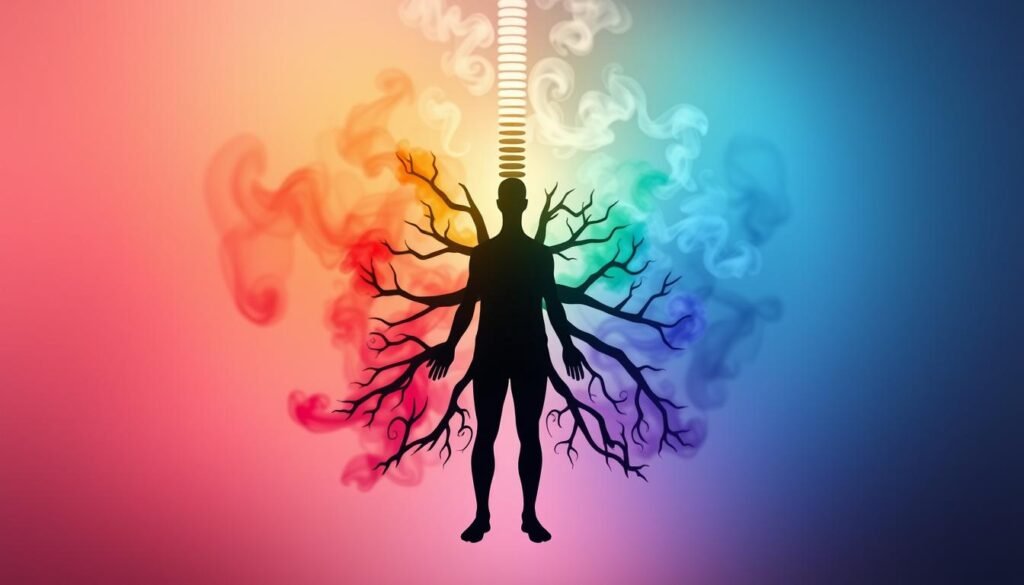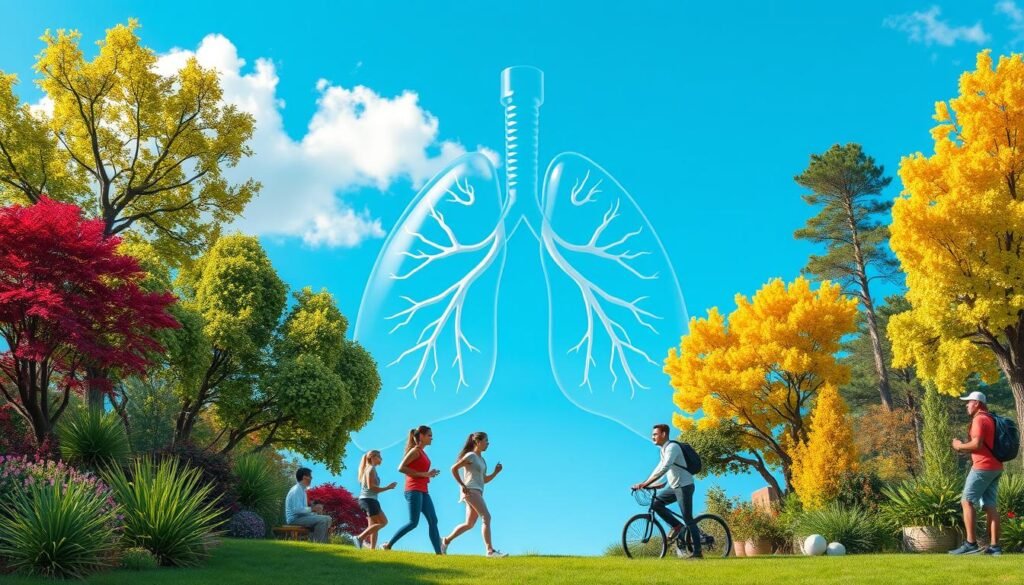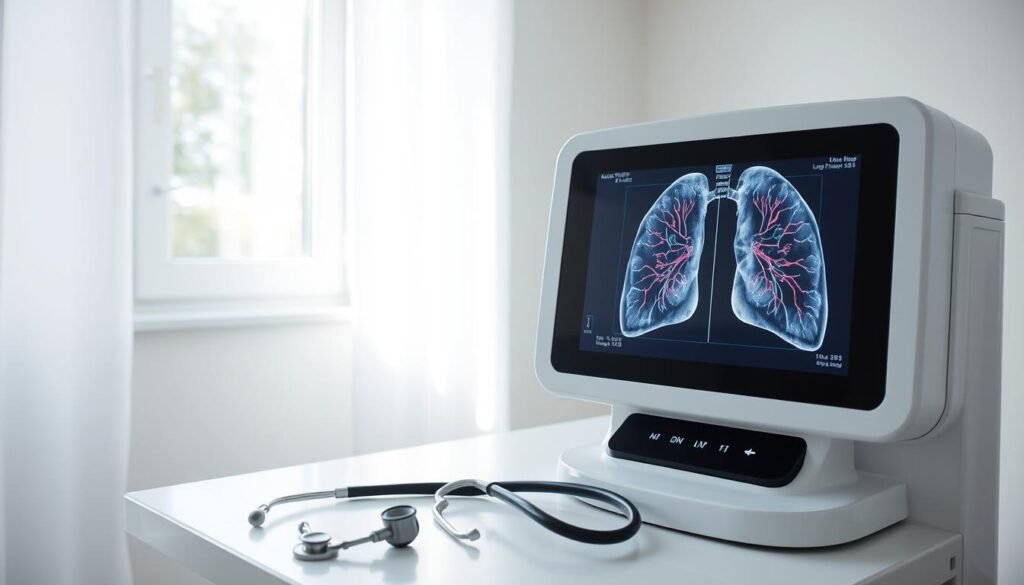Most people who get lung cancer are 65 or older. The average age at diagnosis is around 70. This group makes up more than half of all lung cancer cases.
The highest number of new cases occurs in those 75 to 79 years old. Age greatly affects lung cancer’s prevalence and outcomes. This shows why early detection and screenings are crucial for older adults.
To dive deeper into these statistics, check out key statistics on lung cancer.
The risk of lung cancer goes up with age. This highlights the importance of public health efforts aimed at older people. By knowing which age group is most at risk, we can create more precise health strategies as we grow older.
Key Takeaways
- Most lung cancer diagnoses occur in individuals aged 65 and older.
- The average age at diagnosis is approximately 70 years.
- Age is a significant prognostic factor in lung cancer survival rates.
- 75 to 79-year-olds have the highest diagnosis rates.
- Over 50% of lung cancers are diagnosed in people aged 55 to 74.
- Black men are more likely to develop lung cancer compared to white men.
The Prevalence of Lung Cancer by Age
Lung cancer is the second most common cancer in the U.S., mainly impacting those over 65. The American Cancer Society expects about 234,580 new cases in 2024. Such numbers highlight the need for more awareness and targeted help for those at risk.
About 2,480,675 new lung cancer cases were identified globally in 2022. Men had more cases, with 1,572,045 reported. This showcases the difference in cancer risk between men and women. The highest rates for men were in Turkey, and for women in China. This illustrates the global differences. Also, with 226,033 new cases in the U.S., there’s a clear need for better lung cancer management and education, especially among the elderly.
The average age for a lung cancer diagnosis is 71, showing age significantly affects risk. As we learn more about how age affects lung cancer risk, promoting awareness and prevention is key. These efforts can help combat lung cancer, a major cause of cancer deaths.
| Age Group | New Cases in 2024 (Estimated) | Median Age at Diagnosis |
|---|---|---|
| Under 45 | 15,000 | 39 |
| 45-64 | 85,000 | 57 |
| 65 and older | 134,580 | 71 |
Understanding cancer age risk is vital. We must work on better monitoring and support for these high-risk groups.
For more information on lung cancer statistics, visit detailed resources on cancer diagnosis statistics.
What Age Group is Most at Risk for Lung Cancer?
Lung cancer is a major concern, especially for older adults. Most people diagnosed are 50 years or older. Almost 90.5% of lung cancer patients are between 56 to 88 years old. Smoking greatly increases their risk.
Statistics on Lung Cancer Diagnoses
Most new lung cancer cases are in older adults. Every year, the U.S. sees about 238,340 new cases. Only 10% are under 55, highlighting age as a key risk factor. Young people often get diagnosed late due to vague symptoms appearing in emergencies.
Average Age of Diagnosis
The average age for getting diagnosed is 70. This shows the need for better screening in those at high risk. Screening is crucial, especially for those older or with a history of smoking. For more on early detection, check this resource.
Understanding Lung Cancer Types
Lung cancer comes in various forms, mainly split into two groups: NSCLC and SCLC. These types are different in how common they are, how they behave biologically, and how they are treated. These differences affect how well patients do after treatment. It’s especially important to understand this for older adults, who have a higher risk.
Small Cell Lung Cancer (SCLC)
SCLC makes up about 10-15% of all lung cancer cases. It grows quickly and spreads fast to other body parts. Most people with SCLC used to smoke heavily. Finding this cancer early is hard because it spreads so fast.
Non-Small Cell Lung Cancer (NSCLC)
NSCLC is the most common, making up about 80-85% of cases. It includes three main subtypes: adenocarcinoma, squamous cell carcinoma, and large cell carcinoma. NSCLC grows and spreads more slowly than SCLC. This slower growth can lead to better outcomes if the cancer is caught early. Depending on the cancer stage and type, treatments may include surgery, chemotherapy, and targeted therapies.
| Lung Cancer Type | Prevalence | Growth Rate | Typical Treatment |
|---|---|---|---|
| Small Cell Lung Cancer (SCLC) | 10-15% | Fast | Chemotherapy, Radiotherapy |
| Non-Small Cell Lung Cancer (NSCLC) | 80-85% | Slow to Moderate | Surgery, Chemotherapy, Targeted Therapy |
Key Risk Factors Associated with Lung Cancer
Knowing the key risks for lung cancer helps in its prevention. Smoking is the top cause, responsible for most lung cancer deaths in the U.S. Anyone around smoking has a much higher chance of getting this disease.
Smoking and Lung Cancer
There’s clear proof that smoking leads to lung cancer. Smokers increase their risk and endanger others with secondhand smoke. In Canada, 72% of lung cancer cases are due to smoking. This shows why it’s crucial to have programs to help people quit smoking.
Secondhand Smoke Exposure
Being around smoke even if you don’t smoke is dangerous. Non-smokers living with smokers can get lung cancer from breathing in toxic smoke. Creating smoke-free spaces is vital to protect everyone, especially kids and people with certain health issues.
Occupational Hazards and Their Impact
Workplace hazards also add to lung cancer risks, especially if you smoke. Being around harmful substances like asbestos at work increases these risks. Those who smoke and are exposed to asbestos face a much higher chance of getting lung cancer. Making workplaces safer and having strict regulations can lower these dangers.
Demographic Variations in Lung Cancer Risk
The way demographics link to lung cancer risk shows important trends. It matters a lot when we think about race and gender. Knowing about these differences helps us fight the disease better.
Race and Ethnic Disparities
Race affects lung cancer risk a lot. For example, African American men are 15% more likely to get lung cancer than White men. But African American women are in a different boat. Their risk is 14% less than that of White women. This shows us how health outcomes can differ greatly among racial and ethnic groups.
Gender Differences in Risk
Men and women face different risks when it comes to lung cancer. It used to be more common in men. But now, more women are getting it too. This change makes us think about why it’s happening. It also shows that actions aimed at women might lower these growing numbers.
| Population Group | Risk Level | Comparison to White Counterparts |
|---|---|---|
| African American Men | Increased Risk | +15% |
| African American Women | Decreased Risk | -14% |
| White Men | Baseline Risk | N/A |
| White Women | Baseline Risk | N/A |
The Impact of Age on Lung Cancer Prognosis
Age is a key factor in determining lung cancer outcomes. Studies show that older patients often face poorer survival outcomes. The median age for lung cancer diagnosis is around 70, with many diagnoses after age 65. This shift brings up crucial questions about age and lung cancer prognosis and how effective treatments are.
For patients over 80, lung cancer survival rates drop sharply. They have a median survival of just one year, compared to two years for those under 60. The oldest age groups, especially those over 70, have a high percentage of lung cancer cases. This increases the risk of death.
Lung cancer appears differently depending on age. Younger patients more often have non-small cell lung cancer (NSCLC). In contrast, older patients usually have adenocarcinomas. This difference highlights the disease’s complexity. Older patients are more likely to have advanced disease, affecting their prognosis and treatment options.
Age greatly impacts the chance of receiving treatment. Data shows a clear drop in treatment for patients 80 and older. Better survival rates underline the need for personalized care for the elderly. Tackling the challenges these patients face can improve their life quality.
| Age Group | Median Survival (Years) | % Receiving Treatment | % Referred to Palliative Care |
|---|---|---|---|
| 2.0 | 93.2% | 27.9% | |
| 60–69 years | 1.5 | 89.0% | 26.1% |
| 70–79 years | 1.6 | 86.6% | 29.8% |
| ≥80 years | 1.0 | 71.8% | 44.0% |

Lung Cancer Symptoms by Age Group
It’s important to know about lung cancer symptoms, as they change with age. Older adults show certain symptoms more often. Spotting these early can help start treatment sooner.
Common Symptoms in Older Adults
If you’re 55 or older, watch for these symptoms:
- Persistent cough: This can get worse over time. Many people don’t pay enough attention to it.
- Chest pain: When your chest hurts, it could be a sign of lung issues.
- Breathing difficulties: You might feel out of breath more easily, doing activities or even when you’re resting.
- Hoarseness: A change in your voice could be telling you something’s not right with your lungs.
- Unexplained weight loss: Losing weight suddenly, when you’re not trying to, can be a warning.
From the time people first notice these symptoms, getting diagnosed can take up to two months. Sometimes, it might even take three years. This shows why older adults need to be extra watchful. Symptoms tend to appear when the cancer has grown, which highlights the importance of early awareness.
Lung Cancer Prevention Strategies
Preventing lung cancer takes several steps. The biggest step is stopping smoking. Cigarette smoking causes most lung cancer deaths in the U.S. Smokers are much more likely to get lung cancer than non-smokers. Teaching people about smoking’s dangers is key.
It’s also important to avoid secondhand smoke. It’s a big cause of lung cancer for nonsmokers. Making places smoke-free helps a lot.
Being aware of dangers at work and in the environment is crucial. Radon gas is the second leading cause of lung cancer in the U.S. Working with asbestos and arsenic can increase cancer risk. Strict safety rules are needed.
Cancer survivors should know about risks from chest radiation therapy. Genetics play a role too. Knowing these risks helps people make better choices for preventing lung cancer.

Here’s a brief on how to prevent it:
- Quit smoking and stay away from tobacco.
- Make places you go smoke-free to avoid secondhand smoke.
- Check your home for radon and fix it if needed.
- Follow safety rules at jobs where you’re exposed to carcinogens.
- Know your family’s health history concerning lung cancer.
Lung Cancer Treatment Options
The way we treat lung cancer has greatly improved. Now, treatments are designed to fit each patient’s needs. This is especially important for older adults, who may face more challenges. Thanks to new technologies and methods, doctors can offer personalized care through different therapies.
Advances in Treatment for Older Patients
For older adults, treatment goes beyond just chemo and radiation. Surgery, especially lobectomies with lymph node removal, is key. A less invasive surgery method helps older patients recover faster. This is crucial for those with other health issues.
Studies show more elderly patients can now have surgery for lung cancer. For example, 25% of patients over 75 years can undergo surgery. Less extensive surgeries are also proving effective for those at high risk. This shows that smaller surgeries can lead to good results too.
Unfortunately, older patients often miss out on treatments. Those over 70 are at a higher risk of not getting the treatment they need. This can be due to cost or other health problems. It’s critical to understand why to help them better.
As more older adults need cancer treatment, focusing on their specific needs is vital. Paying attention to geriatric oncology can ensure they get the best care. This will help improve treatment outcomes for older lung cancer patients.
The Role of Early Detection in Survival Rates
Finding lung cancer early is key to beating it. Guidelines by the American Cancer Society suggest yearly scans. These are for those 50 to 80 who smoked a lot over the years. Early checks mean earlier treatment.
Studies show LDCT scans spot early signs of lung cancer. Spotting symptoms and getting screened helps catch it early. Sadly, most lung cancer is found too late, and survival rates drop.
Though the overall five-year survival rate is only 19%, it’s much higher when found early. For example, early-stage lung cancer has a survival rate over 75%. But in stage IV, it drops to less than 10%. Early screenings can make a huge difference.
Still, screening doesn’t replace quitting smoking. Smokers need help to quit. It’s the best way to prevent lung cancer. Early detection and quitting smoking are both important.
Spreading the word about early detection could save many lives. Healthcare providers play a big role. They need to push for screenings among those most at risk.
| Stage | Five-Year Survival Rate |
|---|---|
| Stage IA | 75%+ |
| Stage IV | Less than 10% |
| Overall Average | 19% |

Conclusion
It’s really important to understand how age affects lung cancer risk. This helps us raise awareness about lung cancer. Older adults, especially those between 50-80 years old, are usually at higher risk. This is because of their history of smoking. Lung cancer causes about 27% of all cancer deaths in the U.S. So, it’s key for people in this age group to look after their health and get screened.
Even though treatments are getting better and more people are surviving lung cancer, not many are getting screened. Only 16% of those who should get screened actually did in 2022. This shows we need to do more to find lung cancer early. Early screening can save lives by reducing death rates by up to 20%. It also helps save money on healthcare costs.
Lung cancer is the top kind of cancer around the world. Getting regular screenings and knowing the symptoms can really make a difference. We need to teach older adults about the risks and how to stay healthy. If we focus on education and awareness, we can fight lung cancer better. This will improve life for people at risk.